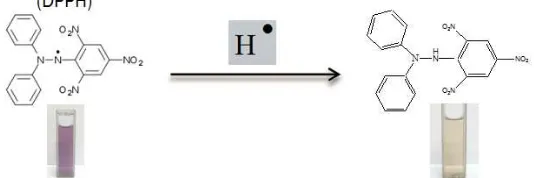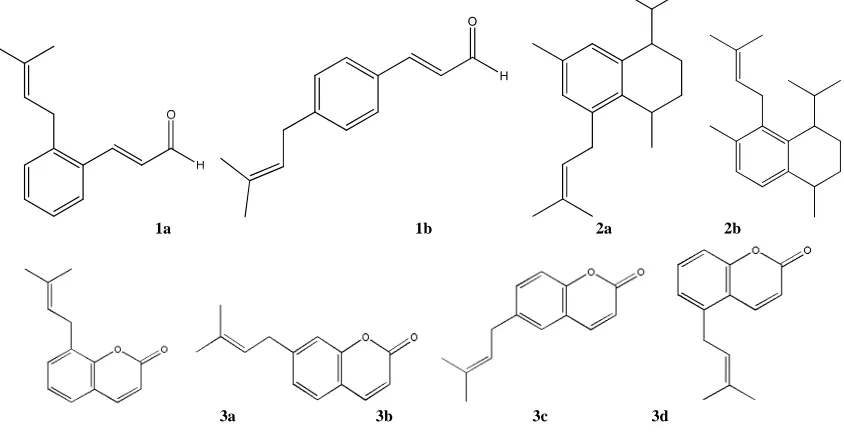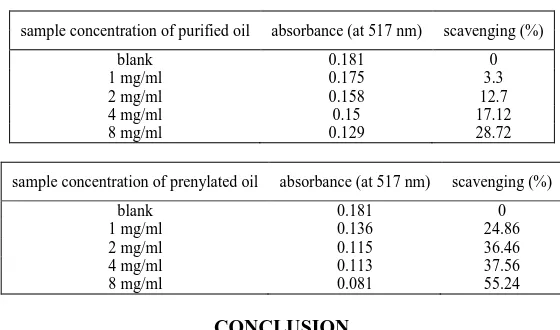Journal of Chemical and Pharmaceutical Research, 2015, 7(1):715-719
Research Article
CODEN(USA) : JCPRC5
ISSN : 0975-7384
Synthesis, characterization and anti-oxidative properties of propolis-like
compound prepared from prenylation of Indonesia’s cinnamon
(Cinnamomum Burmannii) essential oil using
γ-Al
2O
3/NaOH/Na
Antonius Herry Cahyana
1*, Widajanti Wibowo
2, Aditya Pratama
1and Bayu Ardiansah
11
Natural Product Reseach Group, Organic Chemistry Division, Department of Chemistry, Faculty of Mathematics and Natural Sciences, Universitas Indonesia, Depok, Indonesia
2Physical Chemistry Division, Department of Chemistry, Faculty of Mathematics and Natural Sciences, Universitas
Indonesia, Depok, Indonesia
_____________________________________________________________________________________________
ABSTRACT
Nowadays, many of synthetic compounds with potent and diverse biological activity have been prepared from available natural compounds, which are safe, inexpensive and readily available. Propolis is a resinous bee-hive product containing bee secretions and plant resins, popular as a health supplement because of its various biological properties, and composed primarily of artepillin C, a prenylated derivative of cinnamic acid. The hydro-distilled volatile oil of the Cinnamomum burmannii bark was analysed by using gas chromatograph – mass spectrometer (GC-MS). It was rich of phenylpropanoid compounds with cinnamaldehyde as the major compounds. Prenylation of the essential oil was succesfully carried out by using 3,3-dimethyl allyl bromide with heterogeneous catalyst, and the products were identified by GC-MS. Prenylated essential oil showed high antioxidant activities which are suggested due to prenylated cinnamaldehyde, since it is the main compound.
Keywords: antioxidant, cinnamaldehyde, Cinnamomum burmanni, prenylation, propolis
_____________________________________________________________________________________________
INTRODUCTION
Propolis is a resinous hive product collected from plant materials by honeybees and its considered to be a protective barrier against the bee enemies [1]. This material contains more than 300 different constituents including benzoic acid, flavonoids, cinnamic acid derivatives, terpenes, quinones, coumarines, steroids, and amino acids [2-4]. Propolis has attracted researchers’ interest in the last decades because of several biological and pharmacological advantages such as antitumor, immunomodulatory, antimicrobial, antiinflamatory, and antioxidant properties [5]. Moreover, It also has been reported to serve as antibiotics [6] and anticancer agent [7]. Different from the other, Brazilian green propolis is the only propolis containing Artepillin C, a prenylated cinnamic acid and its biological activity has been reported [8-12].
Figure 1. Artepillin C, A Prenylated Cinnamic Acid Found in Brazilian Propolis [8]
inferred that the presence of prenyl group can be associated with an improvement of potency and selectivity for some of these properties [13].
Apart from this, cinnamaldehyde as a major constituent found in Indonesian cinnamon (Cinnamomum burmannii) [14] potent as substrate and play a key role for the synthesis of naturally-like Artepillin C through prenylation reaction since they have similar structure as phenylpropene skeleton with differs in carboxylic acid or aldehyde functional groups. In our present research, we also investigate the antioxidant activity of “Artepillin C–like” compound synthesized from isolated cinnamaldehyde-rich cinnamon oil and prenyl bromide by γ-Al2O3/NaOH/Na
as solid superbase catalyst. The antioxidant capacity of the synthetic compound was measured by using diphenylpicrylhidrazyl (DPPH) radical scavenging method.
EXPERIMENTAL SECTION
Materials
All chemicals were collected from commercial suppliers. Isolation of cinnamaldehyde from cinnamon was performed by using continuous steam distillation apparatus. The purity of isolated cinnamaldehyde was monitored by thin layer chromatography analysis using silica gel F254 plates supplied from Merck. Composition of cinnamon
oil was determined by gas chromatograph-mass spectrometer (GC – MS). Infrared spectra were recorded in KBr pellets or in CHCl3 by the Shimadzu Prestige – 21 Fourier transform infrared (FTIR) spectrophotometer. The unique
maximum wavelength of the starting material and products, as their identity, were determined by using ultraviolet-visible (UV – Vis) spectrophotometer. The presence of the prenylated products were determined using tandem mass spectrometer (MS – MS).
Isolation, Purification, and Identification of Cinnamon Oil
Cinnamomum burmannii (1.5 kg) is added into steam distillation apparatus. After the container sealed, system was
allowed for heating approximately 10 – 12 h. Oily liquid was extracted using dichloromethane, and anhydrous sodium sulfate was added into organic phase. Organic phase was concentrated, and the residue was obtained and weighed. Crude oil was then purified using Si-gel chromatography column with hexane : ethanol (95:5) as eluent. IR spectra of purified oil was recorded using CHCl3 as solvent. Chemical composition of crude and purified cinnamon
oil was performed using GC – MS.
Prenylation of Purified Cinnamon Oil
Heterogeneous catalyst of γ-Al2O3/NaOH/Na have been prepared in our previous work [15]. Purified cinnamon oil
(0.1 g) was dissolved in 50 mL acetone, stirred at room temperature. Prenyl bromide (0.4 g) and γ-Al2O3/NaOH/Na
(0.3 g) was then added and the flask was connected to a condenser, being refluxed (600C) for 24 h. The product mixture was filtered, the filtrate was concentrated and redissolved in ethyl acetate. The undissolved residue was redissolved in ethanol. The concentrated product was stored at 4 0C. Prenylated compounds’ composition was analysed using MS/MS, UV–Vis and IR spectrophotometry.
Antioxidant Activity Assay
[image:2.595.172.439.640.729.2]A 0.1 mM solution of DPPH radical solution in methanol was scanned between 400 and 750 nm to obtain maximum wavelength. The absorbance of DPPH was adjusted to 1.0 with methanol at this maximum wavelength (~510 nm). Afterwards, 5 mL of purified cinnamon oil (with a concentration of 1, 2, 4, and 8 mg/mL) was mixed into 1 mL of 0.1 mM DPPH solution. The mixture was shaked vigorously and allowed to stand in the dark at room temperature for 30 min. The purple colour was getting lighter during reaction (Figure 2). The absorbance of the solution after 30 min was then measured at 515 nm as the end point. Measure the absorbance of the resulting solution at 515 nm at 30 min as the end point. Efficacy of radical scavenging was showed as % inhibition, and the 50% inhibition concentration (IC50) wa calculated [16].
RESULTS AND DISCUSSION
Isolation and Characterization of Cinnamon Oil
[image:3.595.97.519.522.738.2]Continuous steam distillation, a very simple and effective method, was used to obtain cinnamon oil from Indonesian cinnamon bark. The crude oil had unique aroma and was purified using n-hexane : ethanol (95:5). The chemical composition of crude and purified cinnamon oil based on GC – MS determination are shown in Table 1.
Table 1. Chemical composition of crude and purified cinnamon oil
No. Compound Area (%)
Crude Oil Purified Oil
1 Limonene 5.32 2.09
2 Eucalyptol 8.5 6.97
3 p-Cymene 1.78 0
4 α-Copaene 18.69 12.89
5 Bornyl acetate 10.02 9.52
6 Bergamotene 2.05 0
7 β-Caryophylene 8.1 7.26
8 α-Caryophylene 2.01 1.43
9 β-Terpinene 6.89 7.82
10 α-Murolene 2.94 0
11 δ-Cadinene 6.98 6.25
12 Calamene 2.13 2.49
13 trans-Cinnamaldehyde 7.85 20.95
14 Cinnamyl acetate 5.69 10.82
15 Coumarin 0.19 0.62
From the data above, we can conclude that purification step successfully improve the purity of cinnamaldehyde in the mixture, from 7.85 to 20.95% of total area. The IR spectra of crude and purified oil has the same pattern, except for the dissappearance of peak near 3500 cm-1 (–OH stretch) in purified oil, which indicate that hydoxyl-containing compounds has been eliminated during purification step. Both crude and purified oil have significant absorptions at 3057 (aromatic C-H stretch), 2900 (aliphatic C-H stretch, 2700 – 2800 (aldehyde group) and 1650 – 1750 (carbonyl group) cm-1.
Prenylation Reaction and Molecular Structure Determination
Yellow crystal is formed in prenylation of purified cinnamon oil. IR spectrum of the prenylated oil is slightly different from purified oil at 800 – 1000 cm-1 as a result of the prenyl group absorption. Prenylated oil has greater maximum wavelength (314 nm) than purified oil (300nm). This red-shift effect can be associated with addition of prenyl group into the molecule. Based on the MS spectrum, there are 3 constituents in purified cinnamon oil has been identified to be bound to 1 equivalent of prenyl group; m/z cinnamaldehyde = 132,1; prenylated
cinnamaldehyde = 200; calamenene = 202.3; prenylated calamenene = 270.7; coumarin = 146.1; prenylated coumarin = 213.9 (Figure 3).
H O
1a 1b 2a 2b
3a 3b 3c 3d
Antioxidant Activity Assay
DPPH is a model substrate for radical compound. It has purple colour which gives 515 nm of maximum wavelength. If DPPH is scavenged by antioxidative agent, its absorbance will decrease gradually. Scavenging activity of the antioxidative agent was measured by the following equation :
In this research, both purified and prenylated Indonesian cinnamon oil have radical scavenging activity (Table 2). Linear plot are obtained between % scavenging and concentration of sample, and from the linear equation, the IC50
[image:4.595.165.445.234.399.2]value can be readily determined (14.22 mg/mL for purified oil and 6.88 mg/mL for prenylated cinnamon oil).
Table 2. Data result of antioxidant assay
sample concentration of purified oil absorbance (at 517 nm) scavenging (%)
blank 0.181 0
1 mg/ml 0.175 3.3
2 mg/ml 0.158 12.7
4 mg/ml 0.15 17.12
8 mg/ml 0.129 28.72
sample concentration of prenylated oil absorbance (at 517 nm) scavenging (%)
blank 0.181 0
1 mg/ml 0.136 24.86
2 mg/ml 0.115 36.46
4 mg/ml 0.113 37.56
8 mg/ml 0.081 55.24
CONCLUSION
Prenylation reaction of isolated Indonesian cinnamon oil under green condition was successfully achieved with γ -Al2O3/NaOH/Na as solid superbase catalyst. Moreover, It was shown that prenylated cinnamaldehyde play
significant role for the enhanced antioxidant capacity of prenylated cinnamon oil rather than the unprenylated one. This research provides a bright way to develop new antioxidative agent modified from naturally active constituents by prenylation reaction.
Acknowledgements
This research has been financially supported Directorate General of Higher Education (DIKTI) Ministry of Education and Research, Republic of Indonesia through Penelitian Unggulan Perguruan Tinggi (PUPT) grant 2014.
REFERENCES
[1] S Mishima; Y Narita; S Chikamatsu; Y Inoh; S Ohta; C Yoshida; Y Araki; Y Akao; KM Suzuki; Y Nozawa, J.
Etnopharmacol., 2005, 99, 5 – 11.
[2] VS Bankova, SL de Castro, MC Marcucci. Apidologie, 2000, 31, 3 – 15.
[3] MC Marcucci, F Ferreres, AR Custodio, MMC Ferreira, VS Bankova, V Garcia-Viguera, WA Bretz, Z.
Naturforsch C, 2000, 55, 76 – 81.
[4] MR Ahn, K Kunimasa, T Ohta, S Kumazawa, M Kamihara, K Kaji, Y Uto, H Hori, H Nagasawa, T Nakayama,
Cancer Lett, 2007, 252, 235 – 243.
[5] JM Sforcin, J. Ethnopharmacol., 2007, 113, 1 – 14. [6] S Silici, S Kutluca, J. Ethnopharmacol., 2005, 99, 69 – 73.
[7] A Popolo, LA Piccinelli, S Morello, O Cuesta-Rubio, R Sorrentino, L Rastrelli, A Pinto, Nat. Prod. Commun.,
2009, 4, 1711 – 1716.
[8] MC Marcucci, F Ferreres, C Garcia-Viguera, VS Bankova, SL de Castro, AP Dantas, N Paulin, J.
Ethnopharmacol., 2001, 74, 105 – 112.
[9] T Matsuno, SK Jung, Y Matsumoto, M Saito, J Morikawa, Anticancer Res., 1997, 17, 3565 – 3568.
[10] T Kimoto, S Arai, M Aga, T Hanaya, M Kohguchi, M Nomura, M Kurimoto, Gan To – Kagaku – Ryoho, 1996, 23, 1855 – 1859.
[13] RAP Castanheiro, AMS Silva, NAN Campos, MSJ Nascimento, MMM Pinto. 2009, Pharmaceuticals, 2009, 2, 33 – 43.
[14] R Wang, R Wang, B Yang, Inn. Food Sci. Emerg. Tech., 2009, 10, 289 – 292. [15] TM Siregar, AH Cahyana, W Wibowo, J. Chem. Pharm. Res., 2014, 6(10), 349-353.


